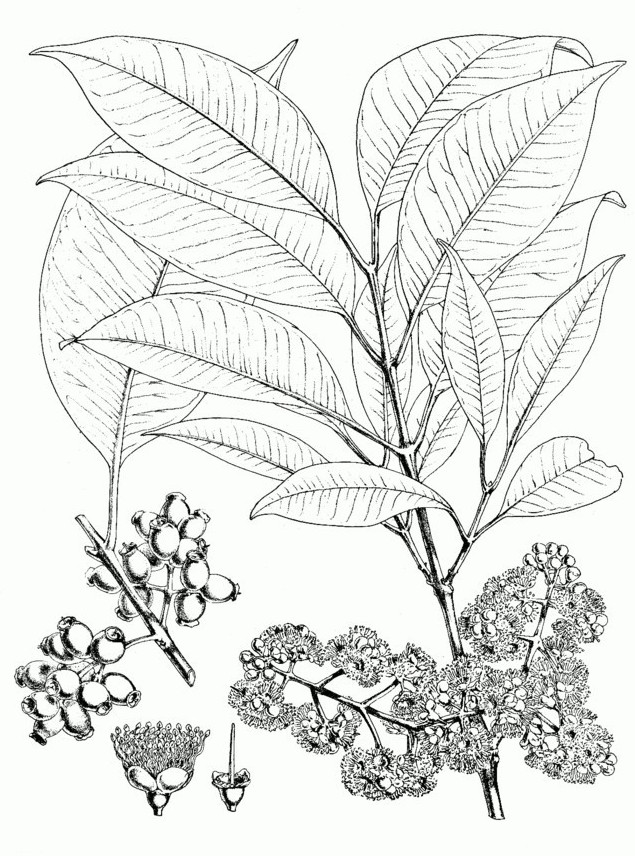Syzygium cumini L. - syn.Eugenia jambolana Lam. - Myrtaceae - jambul, jamun, java plum, Jambulbaum
„The pulp has a astringent sour to sweet taste. Suitable varieties can be eaten raw or processed as fruit. From the fruit juice, wine, spirits and vinegar is produced… From the leaves essential oil is extracted for perfume production.“ http://de.wikipedia.org/wiki/Syzygium_cumini
http://file.scirp.org/Html/11-2700420_21566.htm
„Eugenia jambolana is an evergreen tropical tree of 8 to 15 m height, with smooth, glossy turpentine-smelling leaves. The bark is scaly gray, and the trunk is forked. There are fragrant white flowers in branched clusters at stem tips and purplish-black oval edible berries. The berries contain only one seed. The taste is generally acidic to fairly sweet but astringent. This tree is known to have grown in Indian subcontinent and in other regions of South Asia such as Nepal, Burma, Sri Lanka, Indonesia, Pakistan, and Bangladesh from ancient time…The efficacy of Eugenia jambolana has also been tested in preclinical and clinical studies for hypolipidemic, anti-inflammatory, neuropsychopharmacological, antiulcer, antibacterial, anti-HIV, antidiarrhoeal , and antihypertensive activities.“
[Traditional Indian medicines used for the management of diabetes mellitus., Rizvi, S.I., Mishra, N., Journal of diabetes research, 2013, (2012): 712092-712092] http://www.ncbi.nlm.nih.gov/pmc/articles/PMC3687502/
„In India, the decoction of kernels of Eugenia jambolana (EJ) and extracts of Tinospora cordifolia (TC) are used as a household remedy for diabetes. These also form constituents of many herbal formulations for diabetes that are marketed in this country. The anti-hyperglycemic effect of aqueous and alcoholic extracts as well as lyophilized powder of these two plants was evaluated in diabetic animals using different doses of diabetogenic agents for varying duration (21-120 days) so as to assess their effect in … diabetes mellitus. In the pilot study (mild diabetes), maximum reduction of 73.51 and 70.37% in glucose levels was seen in animals receiving 200 mg/kg per day of lyophilized powder of EJ and 400 mg/kg per day of aqueous extract of TC after 3 and 15 weeks of treatment, respectively. There percent reduction in glucose decreased significantly in the moderate and severe diabetes; 55.62 and 17.72% for EJ and 48.81 and 0% for TC at the similar time intervals.“
[Anti-hyperglycemic effect of Eugenia jambolana and Tinospora cordifolia in experimental diabetes and their effects on key metabolic enzymes involved in carbohydrate metabolism., Grover JK1, Vats V, Rathi SS., J Ethnopharmacol. 2000 Dec;73(3), 461-70] http://www.ncbi.nlm.nih.gov/pubmed/11091000
„The ethanolic extract of seeds of S. cumini increased body weight and decreased blood sugar level in alloxan diabetic albino rats. Level of significance for decrease in blood sugar after feeding alcoholic extract of
S. cumini seeds in various doses was highly significant. The extract feeding showed definite improvement in
the histopathology of islets. The most important finding is that the blood sugar level, which once dropped to normal levels after extract feeding was not elevated when extract feeding was discontinued for 15 days.“
[Effects of ethanolic extract of Syzygium cumini (Linn) seed powder on pancreatic islets of alloxan diabetic rats., Singh, N., Gupta, M., Indian journal of experimental biology, 45(10), 2007, 861] http://nopr.niscair.res.in/bitstream/123456789/5343/1/IJEB%2045%2810%29%20861-867.pdf
„Overall, there is convincing evidence that parts of S. cumini have antihy-perglycemic properties which has mainly been confirmed in a large amount of animal studies. Comparative studies show that in some models, drug preparations were equivalent to widely used oral antidiabetic agents. In contrast to that, clinical studies done so far are insufficient to judge the actual value of S. cumini in adjuvant diabetes therapy. Most clinical data seem not to be much more reliable than pre-1900 case reports.“
[Kumar, A., et al. „Anti-diabetic activity of Syzygium cumini and its isolated compound against streptozotocin-induced diabetic rats.“ Journal of Medicinal Plants Research 2.9 (2013): 246-249] http://www.academicjournals.org/journal/JMPR/article-full-text-pdf/A7B252015305
„The ripe fruits are sweetish sour to taste and are used to prepare health drinks, squashes, juices, jellies and wine. Studies have shown that the berries contain carbohydrates, minerals and the pharmacologically active phytochemicals like flavonoids, terpenes, and anthocyanins. Jamun is a plant with known ethnomedicinal uses. Before the discovery of insulin, Jamun was useful in the treatment of diabetes and is an integral part in the various alternative systems of medicine.“
[Phytochemistry, traditional uses and pharmacology of Eugenia jambolana Lam.(black plum): A review., Baliga, M.S., Bhat, H.P., Baliga, B.R.V., Wilson, R., Palatty, P.L., Food Research International, 44(7), 2011, 1776-1789] https://xa.yimg.com/kq/groups/20803014/1356854551/name/Jambol%C3%A3o_Revis%C3%A3o_Fitoqu%C3%ADmica,+uso+popular+e+farmacol%C3%B3gico.PDF

Brandis,D., Illustrations of the forest flora of North-West and Central India, t.30 (1874) [W.H.Fitch]
http://plantgenera.org/species.php?id_species=992382
